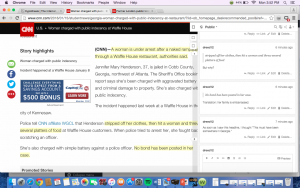Instructions: Copy and past these questions into a new blog post on your sites.gsu.edu WordPress site. Answer the questions, and when you’re done, submit the link to your new post using the submission form.
Questions:
What are the major projects? In a bulleted list, provide links to the project descriptions for each of them.
How will your final grade be calculated?
Points will be earned for all work- attendance, participation, in-class work, major projects, etc. Final grades will be calculated through both quality and quantity of work. The final grading scale will be determined by the top earner.
What is the “submission form” and how do you use it? Embed the form below your answer (hint: Google “embed Google form” to find out how).
The “submission form” is the link/”dropbox” we use to submit all work.
Embed the course calendar and weekly overview below this question.
Where on the course website can you find an overview of what’s due and the readings for each unit?
Hover over “Calendar,” then select “General Plan.”
What is the best way to see an overview of what’s due each week?
Under “Calendar,” select “Weekly Overview.”
What is the attendance policy?
Students can miss no more than two classes, and may lose participation points for missing class.
What are my office hours, and how do you make an appointment to see me outside of class?
Office hours are MW 9-11am and by appointment. E-mail can be used to schedule appointments outside of class and via Skype or Google Hangouts.
How do you earn participation credit? Provide a link to the instructions/guidelines for participation.
Participation credit can be earned through class discussion and participation, engaging with peers and materials, responses to blog posts, extra CTW responses, study group organization and participation, group meetings with you, and blog posts reflecting on course materials.
How many points can you earn by participating in or organizing a study group session?
Participating in or organizing a group study session can earn up to 25 points.
How can you be assured of earning an “A” in this course?
If you complete all major projects, miss no more than two class meetings, and earn at least 2,400 points in the course, you will earn an “A.”
What are the minimum requirements for earning a passing grade of “C”?
If you complete all major projects and earn at least the minimum points available for each, miss no more than two class meetings, and earn at least 1,400 points, you will earn a “C.”
What do you do if you’re not sure how to document your participation in order to earn points?.
To document participation points, write up your work as a blog post and submit the link to the post through our class submission form. This opens our work up for discussion.
